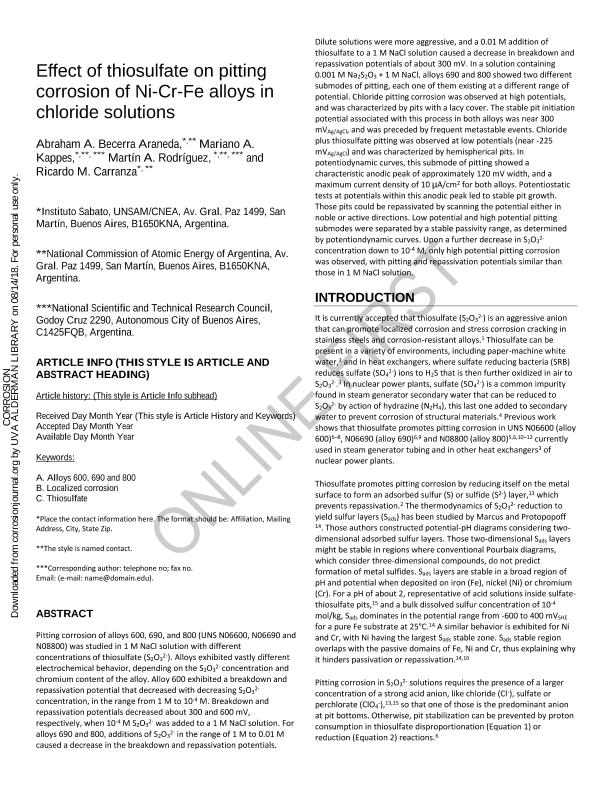Mostrar el registro sencillo del ítem
dc.contributor.author
Becerra Araneda, Abraham Alexis

dc.contributor.author
Kappes, Mariano Alberto

dc.contributor.author
Rodríguez, Martín Alejandro

dc.contributor.author
Carranza, Ricardo Mario

dc.date.available
2020-02-21T22:11:03Z
dc.date.issued
2018-11
dc.identifier.citation
Becerra Araneda, Abraham Alexis; Kappes, Mariano Alberto; Rodríguez, Martín Alejandro; Carranza, Ricardo Mario; Effect of thiosulfate on pitting corrosion of Ni-Cr-Fe alloys in chloride solutions; NACE International; Corrosion; 74; 11; 11-2018; 1214-1228
dc.identifier.issn
0010-9312
dc.identifier.uri
http://hdl.handle.net/11336/98377
dc.description.abstract
Pitting corrosion of Alloys 600, 690, and 800 (UNS N06600, N06690, and N08800) was studied in 1 M NaCl solution with different concentrations of thiosulfate (S2O2 3 −). Alloys exhibited vastly different electrochemical behavior, depending on the S2O2 3 − concentration and chromium content of the alloy. Alloy 600 exhibited a breakdown and repassivation potential that decreased with decreasing S2O2 3 − concentration, in the range from 1 M to 10−4 M. Breakdown and repassivation potentials decreased about 300 mV and 600 mV, respectively, when 10−4 M S2O2 3 − was added to a 1 M NaCl solution. For Alloys 690 and 800, additions of S2O2 3 − in the range of 1 M to 0.01 M caused a decrease in the breakdown and repassivation potentials. Dilute solutions were more aggressive, and a 0.01 M addition of S2O2 3 − to a 1 M NaCl solution caused a decrease in breakdown and repassivation potentials of about 300 mV. In a solution containing 0.001 M Na2S2O3 + 1 M NaCl, Alloys 690 and 800 showed two different submodes of pitting, each one of them existing at a different range of potential. Chloride pitting corrosion was observed at high potentials and was characterized by pits with a lacy cover. The stable pit initiation potential associated with this process in both alloys was near 300 mVAg/AgCl and was preceded by frequent metastable events. Chloride plus S2O2 3 − pitting was observed at low potentials (near −225 mVAg/AgCl) and was characterized by hemispherical pits. In potentiodynamic curves, this submode of pitting showed a characteristic anodic peak of approximately 120 mV width and a maximum current density of 10 μA/cm2 for both alloys. Potentiostatic tests at potentials within this anodic peak led to stable pit growth. Those pits could be repassivated by scanning the potential either in noble or active directions. Low-potential and high-potential pitting submodes were separated by a stable passivity range, as determined by potentiodynamic curves. Upon a further decrease in S2O2 3 − concentration down to 10−4 M, only high-potential pitting corrosion was observed, with pitting and repassivation potentials similar than those in 1 M NaCl solution.
dc.format
application/pdf
dc.language.iso
eng
dc.publisher
NACE International

dc.rights
info:eu-repo/semantics/openAccess
dc.rights.uri
https://creativecommons.org/licenses/by-nc-sa/2.5/ar/
dc.subject
ALLOYS 600, 690 AND 800
dc.subject
LOCALIZED CORROSION
dc.subject
THIOSULFATE
dc.subject.classification
Ingeniería de los Materiales

dc.subject.classification
Ingeniería de los Materiales

dc.subject.classification
INGENIERÍAS Y TECNOLOGÍAS

dc.title
Effect of thiosulfate on pitting corrosion of Ni-Cr-Fe alloys in chloride solutions
dc.type
info:eu-repo/semantics/article
dc.type
info:ar-repo/semantics/artículo
dc.type
info:eu-repo/semantics/publishedVersion
dc.date.updated
2020-02-18T16:06:06Z
dc.journal.volume
74
dc.journal.number
11
dc.journal.pagination
1214-1228
dc.journal.pais
Estados Unidos

dc.journal.ciudad
Houston
dc.description.fil
Fil: Becerra Araneda, Abraham Alexis. Comisión Nacional de Energía Atómica; Argentina. Universidad Nacional de San Martín. Instituto Sabato; Argentina. Consejo Nacional de Investigaciones Científicas y Técnicas; Argentina
dc.description.fil
Fil: Kappes, Mariano Alberto. Universidad Nacional de San Martín. Instituto Sabato; Argentina. Comisión Nacional de Energía Atómica; Argentina. Consejo Nacional de Investigaciones Científicas y Técnicas; Argentina
dc.description.fil
Fil: Rodríguez, Martín Alejandro. Comisión Nacional de Energía Atómica; Argentina. Universidad Nacional de San Martín. Instituto Sabato; Argentina. Consejo Nacional de Investigaciones Científicas y Técnicas; Argentina
dc.description.fil
Fil: Carranza, Ricardo Mario. Universidad Nacional de San Martín. Instituto Sabato; Argentina. Comisión Nacional de Energía Atómica; Argentina
dc.journal.title
Corrosion

dc.relation.alternativeid
info:eu-repo/semantics/altIdentifier/url/https://corrosionjournal.org/doi/10.5006/2923
dc.relation.alternativeid
info:eu-repo/semantics/altIdentifier/doi/http://dx.doi.org/10.5006/2923
Archivos asociados
